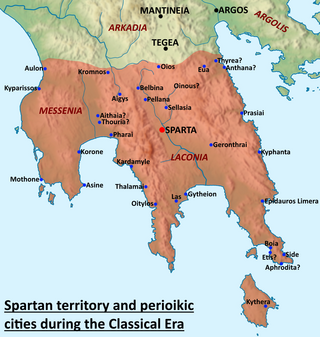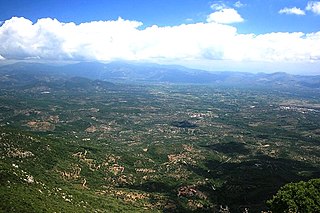Related Research Articles

Ares is the Greek god of war and courage. He is one of the Twelve Olympians, and the son of Zeus and Hera. The Greeks were ambivalent towards him. He embodies the physical valor necessary for success in war but can also personify sheer brutality and bloodlust, in contrast to his sister Athena, whose martial functions include military strategy and generalship. An association with Ares endows places, objects, and other deities with a savage, dangerous, or militarized quality.

In ancient Greek religion and mythology, Artemis is the goddess of the hunt, the wilderness, wild animals, nature, vegetation, childbirth, care of children, and chastity. In later times, she was identified with Selene, the personification of the Moon. She was often said to roam the forests and mountains, attended by her entourage of nymphs. The goddess Diana is her Roman equivalent.

Sparta was a prominent city-state in Laconia in ancient Greece. In antiquity, the city-state was known as Lacedaemon, while the name Sparta referred to its main settlement on the banks of the Eurotas River in the Eurotas valley of Laconia, in south-eastern Peloponnese. Around 650 BC, it rose to become the dominant military land-power in ancient Greece.

Epaminondas was a Greek general and statesman of the 4th century BC who transformed the Ancient Greek city-state of Thebes, leading it out of Spartan subjugation into a pre-eminent position in Greek politics called the Theban Hegemony. In the process, he broke Spartan military power with his victory at Leuctra and liberated the Messenian helots, a group of Peloponnesian Greeks who had been enslaved under Spartan rule for some 230 years following their defeat in the Third Messenian War ending in 600 BC. Epaminondas reshaped the political map of Greece, fragmented old alliances, created new ones, and supervised the construction of entire cities. He was also militarily influential and invented and implemented several important battlefield tactics.

Thermopylae is a narrow pass and modern town in Lamia, Phthiotis, Greece. It derives its name from its hot sulphur springs. In Greek mythology the Hot Gates is one of the entrances to Hades.

The Battle of Thermopylae was fought in 480 BC between the Achaemenid Persian Empire under Xerxes I and an alliance of Greek city-states led by Sparta under Leonidas I. Lasting over the course of three days, it was one of the most prominent battles of both the second Persian invasion of Greece and the wider Greco-Persian Wars.

The Gymnopaedia was an annual festival celebrated exclusively in ancient Sparta, which helped to define Spartan identity. It featured generations of naked Spartan men participating in war dancing and choral singing, with a large emphasis placed on age and generational groups. It is believed that celebration of this festival began in 668 BCE to honour a Spartan victory in Thyrea. The festival likely evolved over time to celebrate other Spartan victories such as that over the Argives in the Battle of the Champions. The Gymnopaedia was primarily in honour of Apollo, but also celebrated Artemis and Leto, who served as representations of the childhood which would soon be left behind by the young participants. Though the festival was ritualistic, it should not necessarily be interpreted as religious. Pausanias describes the Gymnopaedia as "a festival which the Lacedaemonians take more seriously than any other".
Panhellenic Games is the collective term for four separate religious festivals held in ancient Greece that became especially well known for the athletic competitions they included. The four festivals were: the Olympic Games, which were held at Olympia in honor of Zeus; the Pythian Games, which took place in Delphi and honored Apollo; the Nemean Games, occurring at Nemea and also honoring Zeus; and, finally, the Isthmian Games set in Isthmia and held in honor of Poseidon. The places at which these games were held were considered to be "the four great panhellenic sanctuaries." Each of these Games took place over a four-year period, starting with the Olympics. Along with the fame and notoriety of winning the ancient Games, the athletes earned different crowns of leaves from the different Games. From the Olympics, the victor won an olive wreath, from the Pythian Games a laurel wreath, from the Nemean Games a crown of wild celery leaves, and from the Isthmian Games a crown of pine.

Religious practices in ancient Greece encompassed a collection of beliefs, rituals, and mythology, in the form of both popular public religion and cult practices. The application of the modern concept of "religion" to ancient cultures has been questioned as anachronistic. The ancient Greeks did not have a word for 'religion' in the modern sense. Likewise, no Greek writer known to us classifies either the gods or the cult practices into separate 'religions'. Instead, for example, Herodotus speaks of the Hellenes as having "common shrines of the gods and sacrifices, and the same kinds of customs."
The Sacred Band of Thebes was a troop of select soldiers, consisting of 150 pairs of male lovers which formed the elite force of the Theban army in the 4th century BC, ending Spartan domination. Its predominance began with its crucial role in the Battle of Leuctra in 371 BC. It was annihilated by Philip II of Macedon in the Battle of Chaeronea in 338 BC.
In Archaic Greece, an amphictyony, or Amphictyonic League, was an ancient religious association of tribes formed before the rise of the Greek polis.
Various ancient Greek calendars began in most states of ancient Greece between autumn and winter except for the Attic calendar, which began in summer.
Agis II was the 18th Eurypontid king of Sparta, the eldest son of Archidamus II by his first wife, and half-brother of Agesilaus II. He ruled with his Agiad co-monarch Pausanias.
Homosexuality in the militaries of ancient Greece was a significant aspect across the ancient Greek city-states, ranging from being a core part of military life to being an accepted practice of some individual soldiers. It was regarded as contributing to morale. Although the primary example is the Sacred Band of Thebes, a unit said to have been formed of same-sex couples, the Spartan tradition of military heroism has also been explained in light of strong emotional bonds resulting from homosexual relationships. Various ancient Greek sources record incidents of courage in battle and interpret them as motivated by homoerotic bonds.

Karyes is a village of the Peloponnese peninsula, which is located in the southern part of Greece. The Peloponnese is made up of a number of states and Karyes belongs to the state of Laconia in which Sparta is the capital. Karyes gets its official name from the word ‘walnut’ due to the village having many walnut trees and has been spelled a number of ways such as Karyes, Karyai, Karya, Caryes, Caryai and Caryae. It should not be confused with some other villages in Greece which go by the same name such as Caria of Asia Minor, Karyes, Mount Athos, Karyes, Pieria, Karya of Argos, and Karyes of Chios. Karyes also goes by the name of Arahova which was thought to have originated from the Slavic word for walnut. The village of Karyes is the birthplace of the six caryatid maidens which are featured in architecture in the place of columns on the ancient and world famous Erectheion of the Athenian Acropolis.

The First Messenian War was a war between Messenia and Sparta. It began in 743 BC and ended in 724 BC, according to the dates given by Pausanias.

The ancient Olympic Games were a series of athletic competitions among representatives of city-states and one of the Panhellenic Games of Ancient Greece. They were held at the Panhellenic religious sanctuary of Olympia, in honor of Zeus, and the Greeks gave them a mythological origin. The originating Olympic Games are traditionally dated to 776 BC. The games were held every four years, or Olympiad, which became a unit of time in historical chronologies. These Olympiads were referred to based on the winner of their stadion sprint, e.g., "the third year of the eighteenth Olympiad when Ladas of Argos won the stadion". They continued to be celebrated when Greece came under Roman rule in the 2nd century BC. Their last recorded celebration was in AD 393, under the emperor Theodosius I, but archaeological evidence indicates that some games were still held after this date. The games likely came to an end under Theodosius II, possibly in connection with a fire that burned down the temple of the Olympian Zeus during his reign.
Spartan women were famous in ancient Greece for seemingly having more freedom than women elsewhere in the Greek world. To contemporaries outside of Sparta, Spartan women had a reputation for promiscuity and controlling their husbands. Spartan women could legally own and inherit property, and they were usually better educated than their Athenian counterparts. The surviving written sources are limited and largely from a non-Spartan viewpoint. Anton Powell wrote that to say the written sources are "'not without problems'... as an understatement would be hard to beat".

The Theban–Spartan War of 378–362 BC was a series of military conflicts fought between Sparta and Thebes for hegemony over Greece. Sparta had emerged victorious from the Peloponnesian War against Athens, and occupied an hegemonic position over Greece. However, the Spartans' violent interventionism upset their former allies, especially Thebes and Corinth. The resulting Corinthian War ended with a difficult Spartan victory, but the Boeotian League headed by Thebes was also disbanded.
References
- ↑ The Cambridge History of Greek and Roman Warfare by Philip Sabin Page 100 ISBN 0-521-78273-2 (2007)
- Pilgrims and pilgrimage in ancient Greece By Matthew Dillon Page 3 ISBN 0-415-12775-0 (1997)
(Pindar. Isthm. ii. 23; Strabo. viii. p. 343; Krause, Olympia, p. 40, &c.) ![]() This article incorporates text from a publication now in the public domain : Smith, William, ed. (1870). Dictionary of Greek and Roman Antiquities . London: John Murray.
This article incorporates text from a publication now in the public domain : Smith, William, ed. (1870). Dictionary of Greek and Roman Antiquities . London: John Murray.{{cite encyclopedia}}: Missing or empty |title= (help)